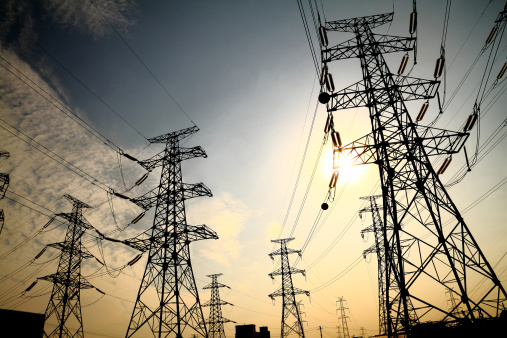Infrastructure
Rising Interest Rates Bring New Risks to Utility Dividend Investors
Published:
Last Updated:
Utility investors have been able to enjoy a true safe haven when it comes to collecting high-yield dividends and above-market dividend yields for years now. That may be coming to an end. The rise in long-term Treasury yields to above 2.10% on the 10-year Treasury is just one small step in this process. If long-term Treasury yields keep rising, utilities will be a sector that investors will think that the lights went out in.
Analyst downgrades in the sector are only magnifying what investors have to fear. These downgrades were seen in Exelon Corp. (NYSE: EXC) and FirstEnergy Corp. (NYSE: FE) and have reminded investors of the risks in what have been considered to be the safe haven stocks in the electric utility and power generation stocks. For simplicity, we have not segregated the actual utilities with retail customers from the companies who specialize in power generation and transmission.
Utility sector investors have to worry about a long-term trend of rising interest rates. A short-term spike will have little impact, but if rates rise rapidly or if they rise steadily over a long period it really hurts utilities. The risk is also not just that investors may prefer to go after more steady bond yields. Utilities have high operating costs and they borrow heavily to pay for infrastructure investments in power generation and power transmission via power lines.
As utilities invest for trends based 10-years, 20-years, and longer in the future, they tend to borrow funds based on 10-year to 30-year maturities. A rise of 200 basis points in a two-year Treasury notes can swing up and down rapidly, but locking in borrowing at 100 basis points or 200 basis points higher for a period of 20 to 30 years really alters a utility’s ability to invest.
The Utilities Select Sector SPDR (NYSEMKT: XLU) is down almost 1% at $38.46 so far on Tuesday against a 52-week trading range of $$33.85 to $41.44. Yahoo! Finance represents its dividend yield as 3.72%. Keep in mind that this yield is still currently 160 basis points higher than the 10-year Treasury. Now if you want to consider the risks, the peak cycle yield on the 10-year Treasury back in just 2011 and that yield is close to the same as where the 10-year Treasury yield was. If you want to know what risk this leaves you as a utility investor, the Utilities Select Sector SPDR (NYSEMKT: XLU) was around $31 per share at the start of 2011 and the yields in utility stocks at that point were often 5%.
We once wrote that utility stocks were becoming the new equivalent of bank CDs for investors. The risk now is that those investors will have to panic out of utilities for safer dividend yields elsewhere. Now compare the yields of today knowing that many of these utilities yielded well over 5% in 2011:
American Electric Power Co. (NYSE: AEP) was yielding over 5% in early 2011 versus about 4.1% now. AEP shares are down about 2.5% at $46.52 with a $22.6 billion market cap against a 52-week range of $38.15 to $51.60.
Exelon Corp. (NYSE: EXC) is trading down 7.5% at $32.06 with a yield of 3.6% and a 52-week trading range of $28.40 to $39.82.
FirstEnergy Corp. (NYSE: FE) is trading down 7.3% at $39.50 against a 52-week range of $38.26 to $51.14. Its yield is now 5.2%.
PPL Corp. (NYSE: PPL) is trading down 2% at $29.97 and now yields 4.8% with a 52-week trading range of $27.10 to $33.55.
NextEra Energy Inc. (NYSE: NEE) is down only 0.4% at $77.00 today against a 52-week range of $64.31 to $82.65. its yield is only 3.4%.
Read Also: Mortgage REITS Under Threat of Treasury Bear Market
At least one electric and gas utility is not getting taken under the water today. PG&E Corp. (NYSE: PCG) is up 0.2% at $46.24, although its yield is under 4% now and its 52-week range is $39.40 to $48.50. Dynegy Inc. (NYSE: DYN) is also bucking the trend under its restructured operations and its shares are up 1.6% at $24.33 on the day.
There is at least some good news here. The price of the underlying stocks might not actually go back and retest the formal prices of just over two years ago. This would be because most utilities have raised their dividend payments for several years in a row now. That would create a situation where a yield-adjustment might not be as bad for utility holders relative to price performance might keep investors from getting crushed.
As far as how high Treasury yields can go, the risk is that they can rise forever even if that risk seems minimal. The old saying is that high prices often cure high prices, and the same can occur in higher bond yields if investors think that they can just get a safe yield in long-term Treasury notes and bonds.
Finding a qualified financial advisor doesn’t have to be hard. SmartAsset’s free tool matches you with up to 3 fiduciary financial advisors in your area in 5 minutes. Each advisor has been vetted by SmartAsset and is held to a fiduciary standard to act in your best interests. If you’re ready to be matched with local advisors that can help you achieve your financial goals, get started now.
Thank you for reading! Have some feedback for us?
Contact the 24/7 Wall St. editorial team.